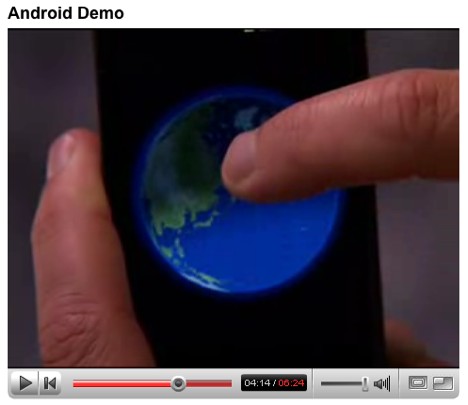Four minutes into this demo of Google’s Android mobile platform, you get to see a 3D globe that you can spin by dragging your finger across the touch screen:

But it’s not Google Earth; it’s an application that the presenter, Steve Horowitz, calls “global time”, presumably because it can show you what time of day it is on different parts of the planet. I bet this is what the New York Times supposed was Google Earth, and it is certainly what Robert Scoble erroneously refers to as “a Google earth map” in his post about that video. (Still, if he hadn’t called it that, my RSS reader’s filters wouldn’t have picked it up, so I can’t complain too loudly:-)
Horowitz says the spinning globe was written using Android’s built-in support for integrated 3D graphics if the device has it — and a bit later he is showing us a version of the first-person shooter Doom. The demo hardware reference device on which he shows both the globe and Doom is a bit bigger than an existing mobile phone, though.
Two things come to mind:
- Built-in support for 3D graphics on a mobile device running Linux makes it quite likely, I imagine, that we will eventually get a version of Google Earth. If the much-ported Doom can run on it today, it’s only a matter of time before Google Earth and Second Life (which also comes in a Linux version) are running on it. Now there’s a scary thought: Playing Second Life continuously from anywhere and anytime in your first life. (And imagine the things you could do with it if such a device were to have motion sensors:-) I wonder if this will be the start of mobile phone devices encroaching on Sony PlayStation PSP’s market segment.
- In the demo, the “global time” application is not shown being zoomed in. But even if it can do so, props should go to Swedish company Wayfinder for their visionary zoomable globe/map hybrid that launched in May 2006. Watch the 90-second video demo of Wayfinder Earth here. Wayfinder’s Earth is 2D masquerading as 3D, of course, but as long as true 3D isn’t feasible on truly mobile phones, that will be the way to go.
A bit later in the video you also get to see a demo of Google Maps that looks very similar to how it works on the iPhone, although the Android version has support for Street View, and you can scroll and zoom the panorama using touch-screen gestures. I’d be surprised if that doesn’t come to the Apple iPhone soon, as it is the obvious enhancement to Google Maps on a touch screen.
I’m surprised how far along Android is on the demos. It is quite similar in aesthetics and functionality as the iPhone, I feel, which to me suggests that Android and iPhone will be setting the benchmark in 18 months time. Those mobile operating systems that do not by then support touch-screen pinching and liquid graphics will be history.
For me, the demonstration of StreetView they included looked like a no-brainer for focus in development. I had suspected that StreetView would prove be a superior mobile visualization — and seeing the demonstration, I think that I was correct in that thinking.
Among other things that look encouraging anyway.
Stefan,
I’m guessing it’s a stripped version of GE ported to OpenGL ES, simply because the texture and atmospheric halo look almost identical.
I imagine it might be a bigger challenge to get free zooming & flying working, since it still requires more RAM, bandwidth, and compute power than most mobiles have. Even the 2D maps example, which is much more lightweight in terms of those things, seemed to be pushing the limits of 3G bandwidth.
RE: two things that come to mind…
Since 2003 working on a mobile location aware 3D immersive metaverse sim app as a side project I cant wait to move it into Google’s / Multiverse VWorld, and on Android (probably to coincides with Camerons releases new his new flick “Avatar”? What is bound to happen is the amount of [insert global eyewear brand] glasses that are going to be sold with integrated “symbology” projected directly by Silicon Valley-based Vision Systems International and Helmet Integrated Systems.
What is scarey is the amount of mishaps (walking,driving, missed bus/train), from a lack of goal directedness. We see in medical simulation from ‘fixation error’ will increase in users trying to cognitively balance their load.